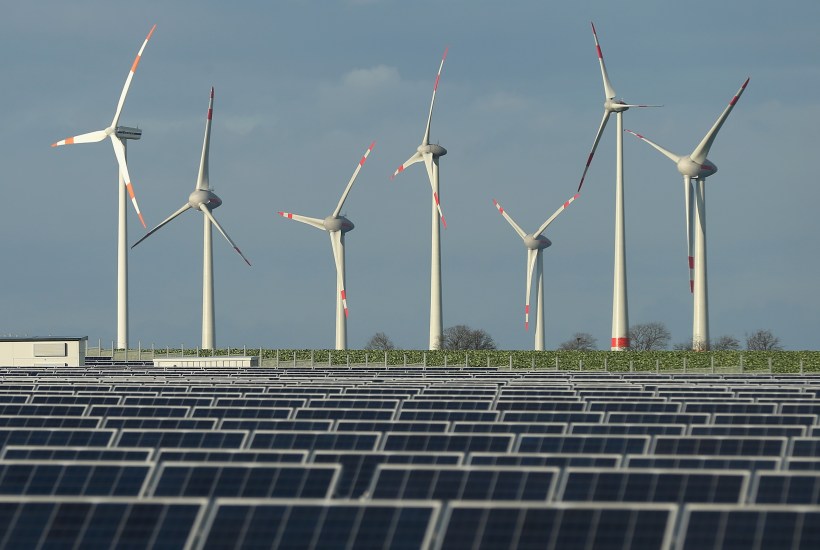Is renewable electricity cheaper than coal?
A recent article by Stephen Long for the ABC had the tag-line, “The tipping point’s been reached: renewable energy is now a cheaper source of power for Australia’s future electricity needs than coal” (and an intriguing URL path: “angus-taylor-energy-minister-power-price-solution-curious”). He certainly had some convincing data. He referred to a long-term deal signed by Origin last year, to “buy electricity from the Stockyard Hill wind farm being developed west of Ballarat in Victoria, reportedly at less than $55 a megawatt hour”.
On the other hand, conservatives have been saying repeatedly that renewables are causing electricity prices to increase.
The problem is not that Long is wrong, but the argument presents a false dichotomy. Yes, renewables provide the cheapest energy and yes, they cause the price of electricity to increase.
What the quoted wholesale price fails to reflect is that for your $55 paid to a wind generator, you only get energy. You don’t get firm capacity, and you don’t get sufficient system stability. This means that in addition to paying these wind farms and solar arrays, you have to pay someone else for firm capacity and stability. The cost of energy plus capacity plus stability is still more expensive overall than a traditional fleet of synchronous, fuel-based generators. Though there are markets for those services (such as the ancillary services market), the total cost is difficult to measure. Nevertheless, if renewables were to account for 100 per cent of generation, the storage and stabilisation technology currently available is nowhere near capable of handling the instantaneous differences between supply and demand. The closer we move towards 100 per cent renewable, the more we pay for that technological shortfall.
But wait, Stephen Long also used AEMO to back up his claim:
It’s a fact. The cold, hard numbers show that new renewable energy is supplying cheaper electricity than new coal-fired power plants could and will continue [to] do so.
No less an authority than the Australian Energy Market Operator agrees.
In a recent report, based on deep, sophisticated modelling, it looked at the most economical way to replace our fleet of ageing coal plants as they retire.
“The lowest cost replacement for this retiring capacity and energy will be a portfolio of resources, including solar (28 gigawatts), wind (10.5 GW) and storage (17 GW and 90 GWh), complemented by 500 megawatts of flexible gas plant and transmission investment,” it said.
This “recent report” was an Integrated System Plan written by AEMO in July, which outlined a raft of improvements that can be made to the Australian network to support the minimum levels of energy security that society will tolerate. However, a browse of the AEMO plan will reveal that it also:
1 Assumed that there would be policy to support emission reduction targets.
2 Strongly recommended that current coal-fired assets be kept online for as long as feasibly possible (so it was hardly saying that our coal generation is an anachronism).
3 Also recommended installation of flexible gas-plant (so it wasn’t saying fossil fuels are an anachronism yet, either).
4 Predicted that by 2030, a distributed renewables-based generation system would be cheaper overall than coal. It did not say that this was currently the case.
5 Said it was energy neutral. That is, flexible coal plant could be used to implement parts of the plan, rather than flexible gas plant (though industry in Australia appears unconvinced that coal can actually deliver on flexibility).
So this AEMO report was being used to answer a question that it hadn’t even asked, and it does not support his conclusion.
It’s not just the ABC though. The market itself has had problems with not looking past the wholesale energy price.
I saw a presentation last week that made a comparison between “value-based” and “price-based” decisions. The idea is that many companies make cheap price-based decisions to their harm because they compromise other things that they value, such as quality and schedule. This is another false dichotomy: price and value are not opposites—what is price, if not a way to measure value? The real problem is when a company does not define the cost of delayed schedules or poor quality. Then their accounts department can’t see these “hidden costs” that their price-based decision is incurring.
The same thing happened in the electricity market. Back when the market was set up, all energy generation came from fuel-based, synchronous equipment, so everything that provided energy also provided inertia and firm capacity, and an ‘energy price’ was an effective single currency. Thus, our energy providers bid onto the market from least to most expensive energy (a “price-based” decision). But over time we gained more and more asynchronous generators with unpredictable availability which, due to low costs, could still undercut the market. It seems that while we umm’d and aah’d over putting a price on carbon, we didn’t immediately realise we’d taken the price tag off reliability and capacity.
The result was that, in addition to the subsidy that renewables received from the government, they effectively received subsidies from the rest of the market. They were providing less value, but the market couldn’t see it. An example of this is ‘behind-the-meter’ solar panels. AEMO has no powers to turn them on or off; they are permanently connected, but with highly variable output (depending on how much sun there is). Households that self-generate from rooftop solar, especially under generous, legacy feed-in tariff schemes, are not helping to foot the bill for the network connection, quality, reliability and availability that they benefit from.
So the argument that coal is more expensive than renewables is fallacious and incomplete. However, it’s no good committing the crime of over-simplification on the other side of the aisle either, where I frequently hear, ‘what we need is “reliable base-load power”.’
Of course, we need reliable base-load power, but arguably we already have it. What the AEMO plan put forward (and what AGL also proposed for replacing Liddell’s capacity) is that the system needs more stabilisation, variable-output generation, storage and interconnections. In other words, we need equipment that can efficiently provide everything that our wind farms and solar arrays aren’t providing. Insofar as this is to accommodate our existing wind-farms, then it’s probably the right call. Base-load power stations are not good at varying output in response to demand and, as a result, neither coal nor nuclear are the right shape to fit that sort of gap in our supply infrastructure. Forcing through a new coal project, nationalising Liddell, building a nuclear power-plant… these ideas would not help.
I’m inclined to think that the market should be making the next decision. This will work if it is properly set up to make value-based decisions—i.e., if it values the same things that consumers value, including quality, reliability, and availability. Such a market will be a place where problem-solvers, rather than problem-creators are always rewarded. Though I can’t see everyone agreeing what price to put on sustainability, at least the price of capacity and reliability we should be able to get right.
Personally, I do really want to see renewable electricity succeed. I want the technology to improve and the price to decrease, and I think it will. But there is no point pretending that this has already happened, or that technology is more advanced than it is. There is especially no point justifying subsidies on the basis of combatting climate change when we know the actual impact on climate change will be negligible.
Last week I attended the Australian Pipeline and Gas Association conference. After a comprehensive presentation about hydrogen for energy storage, someone asked how we can expect our politicians to embrace a 20-year view when they can’t even co-operate on a three-year timescale? The presenter’s answer was responsible and very simple: Make it economic. If our solution is an economic one, then it won’t provide upwards pressure on prices, and that will make politicians happy. And if our solution is economic, then we won’t need the politicians.
He was right. We need to develop sustainable solutions for stability and capacity that fall within the cost difference between wind and coal energy, that compete in their own right. At the least, if the government or investors or environmentalists or philanthropists want to support renewables, then they should foot the bill, not the rest of the market. If we want to advance renewables, then we should invest in research, in invention, in some real R&D. This space is ripe for some long-sighted, entrepreneurial spirit. The prediction is that renewables will be cheaper than fuels by 2030—now that’s a worthy goal.
Nick Kastelein is a Christian and a conservative who grew up and lives in Adelaide where he works for an engineering consultancy.
Got something to add? Join the discussion and comment below.
Got something to add? Join the discussion and comment below.
Get 10 issues for just $10
Subscribe to The Spectator Australia today for the next 10 magazine issues, plus full online access, for just $10.


























Comments
Don't miss out
Join the conversation with other Spectator Australia readers. Subscribe to leave a comment.
SUBSCRIBEAlready a subscriber? Log in